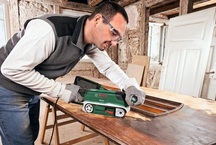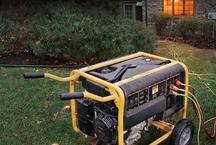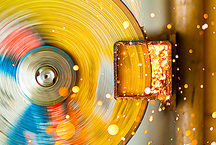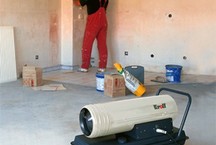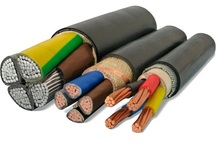
Photo: prorabtools.ru
Interruptions in electricity, unfortunately, in our time is far from uncommon. If this happens every six months and lasts about half an hour, they may not cause too much inconvenience. But when, on average, two or three times a month you have to arrange an evening by candlelight, the situation becomes not at all bright. There is no lighting, the refrigerator is being defrosted, the boiler is not working ... So, you need your own generator for the house. And this can not be called just a whim or desire for increased comfort. This is an adequate assessment of the situation, a way to solve the problem.
Of course, one cannot say that the generator is vital for everyone, but in many cases it will help him to easily get rid of some unpleasant moments. At the same time, the purchase decision most often comes in a huge number of questions: it is not clear where to start, how to choose from the huge number of the proposed equipment models the one that will be the ideal option for the task.
Let's start by setting goals.
When choosing a generator, the first question to be answered is: "What is the purpose of using it?"
Such equipment can serve as the main source of energy. This is necessary if it is impossible or meaningless to connect to a centralized power supply network (for example, in the country, on temporary construction sites). But most often a minipower plant is used as a reserve for an emergency in the main supply system.
When choosing a generator as the main power source, the characteristics of the unit, such as its
- sufficient power
- relatively large lifespan
- economy,
- reliability,
- presence of an extensive service network,
- compactness and weight (if necessary frequent transportation),
- convenience in operation.
In this case, convenience is no less important than, for example, the reliability of equipment. Few people will like to run to the generator every 3-4 hours around the clock to add fuel or repair it after six months, while leaving the house without electricity.
With regard to efficiency, fuel consumption and cost always becomes one of the determining factors when choosing any equipment. Finally, the power of the unit must be chosen so that consumers do not think about what is currently plugged in and what else can be turned on without overloading the generator.
Most often, the power plant is required as a backup power source, so let's dwell on this option.
What generator of power to choose for home or garden?
Approximate calculations in this case will not pass, so you should pay special attention to this moment. The principle is quite simple: you need to add the power of all individual consumers, which should be included in the network at the same time. All the necessary data can be found on the labels, nameplates or instructions on the equipment. You can refer to the data specified by the manufacturers (on the Internet today you can find instructions on almost any model of equipment or instrument).
It is very important to pay attention to the fact that it is necessary to add the power values not in the usual kW, but in kVA (kilovolt-amperes).
For reference: in kVA, the total power of the equipment is measured, which includes the sum of its active (kW) and reactive (kVAr) component. Depending on the specific features of the work of a specific consumer, their ratio may differ significantly from each other, therefore, calculations are performed in this way.
Also, when determining the power, starting currents are of great importance, which for some types of equipment can exceed the nominal values by 3-6 times.
Starting current - the current consumed by the motor from the mains during start-up (i.e. when the device is turned on).
So, for example, in the presence of a pumping station, it is worthwhile to use the power of the aggregate multiplied by a factor of 3.5–4 (depending on the specific model) when calculating. The same situation will be with the refrigerator, air conditioning, washing machine.
To the received figure it is necessary to add 20-30% power reserve, which will allow the generator to work in the optimum mode for itself even in case all the intended consumers are included in the network. Then, from the standard power range of generators, the nearest higher value is selected. The issue is resolved.
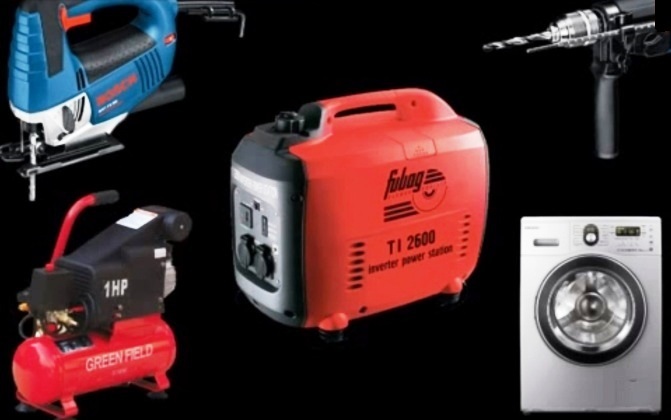
Photo: www.vseinstrumenti.ru
In most cases, if you need to connect the minimum number of consumers (several light bulbs, a TV and a refrigerator) choose a gasoline generator with a power of 2-3 kW. If at home, for example, there is a workshop and power is required for several tools, an aggregate of 6 kW is required. With frequent use of the welding machine, the best solution would be to purchase a specialized welding generator.
What can be connected to a low power generator?
Low-power generators (0.5-2 kW) are most in demand because of their relatively low cost, as well as the ability to connect a minimum list of consumers who require high reliability in power supply. With this choice for the house in the first place often goes the connection of lighting (an average of about 6 lamps), heating boiler, household appliances (refrigerator, iron, TV).
|
0.5 kW |
1-2 light bulbs, phone charger, laptop / |
|
1 kW |
2-3 light bulbs, laptop, phone charger / |
|
2 kW |
3-4 light bulbs, boiler, laptop, refrigerator, telephone charger, TV |
Gasoline, diesel or gas?
One of the fundamental points in the choice of the generator, which follows from the previously obtained power value, is the type of fuel used in the operation. There are only two unambiguous situations in this case:
- if you need a generator with a capacity of up to 2-3 kW, in this case, you need a gasoline model,
- if the power of the equipment is more than 15 kW, then the diesel is your option.
For both situations, the explanation is only one: electric generators operating on a different type of fuel are not produced.
As for the intermediate indicators, everything is a bit more complicated. Often crucial is the cost of equipment and its subsequent operation, as well as features of its future application.
Gasoline generators
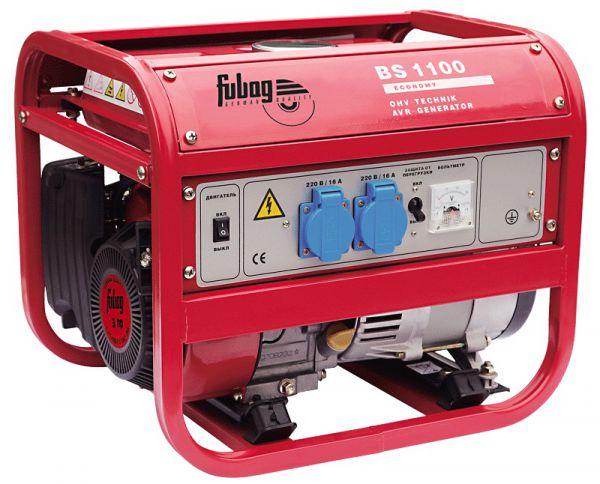
The main characteristics of such equipment are
- compactness
- ease of transportation
- low cost of mini power plants,
- low noise
- higher cost of fuel
- resource from 500 to 3000 hours (depending on the model and brand).
This option is great for situations where constant transportation of a power plant is required, it is switched on rarely and for a short time.
Separately, I would like to draw attention to the value of the indicator "lifespan"when choosing a technique. This figure means the number of hours after which the equipment must undergo a scheduled comprehensive service. Simply put, the number of operating hours is the average duration of the generator between repairs according to test data of the selected model by the manufacturer.
Inverter Generators
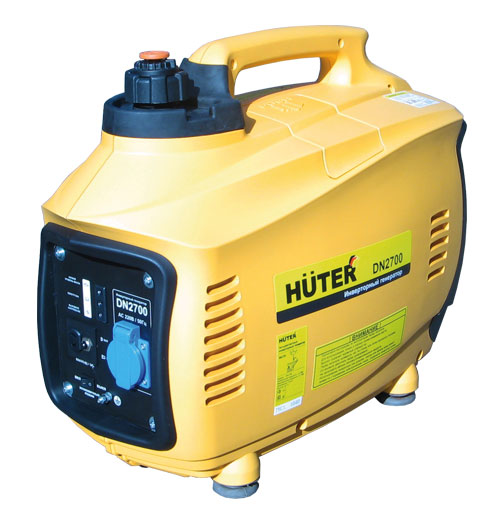
Inverter-type petrol generators are one of the best options for choosing this class of equipment. They differ from traditional equipment with the presence of engine speed control and electronic ignition system.At the same time, the efficiency of such units is due to the fact that the number of revolutions changes depending on the load, which allows to significantly save fuel. As a result, the electronics fully control the level of the generated voltage.
Diesel generators
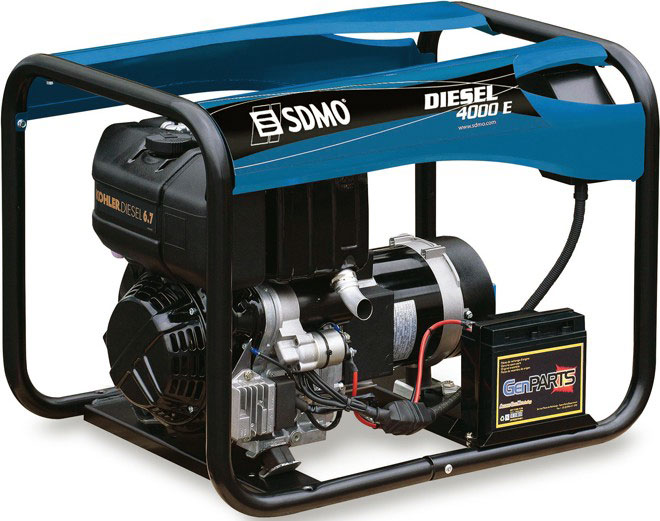
Photo: www.ers-energo.ru Diesel generator SDMO DIESEL 4000 E
In this case, there is a choice between a stationary and portable installation (in other words, between a power plant with water and air cooling). Air diesel generators are perfect for frequent problems with electricity as a reserve. They have a lifespan of about 4000 hours, are economical to operate, and withstand more intensive modes of operation compared to gasoline counterparts.
If all the benefits of civilization are far away and there is a high probability that problems with power supply may arise at any time and it does not take long to last, a stationary diesel generator with water cooling is what you need. To say that they are reliable - to say nothing. They can work around the clock, and the service life is 40,000 hours. Another feature is weight (most often it is about 200-250 kg), although in this you can find your own "plus": to steal such a generator even with a great desire will be complicated.
Gas generators
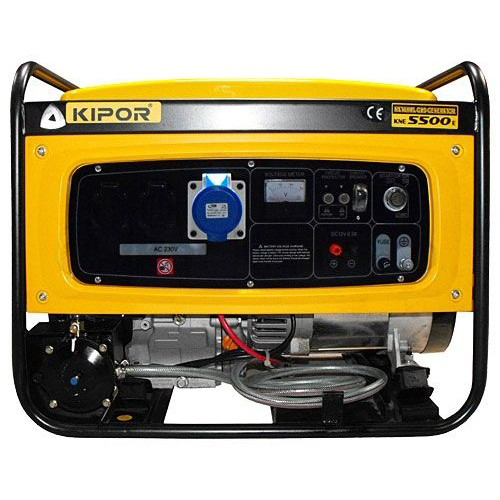
Recently, gas generators have become a worthy (though not very common) alternative to aggregates running on gasoline or diesel. Its main merits can be called
- low cost of fuel (besides, it is very convenient, that there is no need to monitor the level of fuel in the tank, especially when the generator runs on natural gas);
- high efficiency;
- low noise level;
- environmental friendliness.
disadvantages
- high cost of equipment;
- the difficulty of transporting liquefied gas (in the absence of a source of fossil fuels);
- complex safety measures during operation;
- the difficulty of connecting to the trunk line;
- connection requires specialists with experience in performing such work.
One or three phases?
This question is also fundamental, like the previous ones, because a single-phase and three-phase generator is completely different devices that have their own conditions for operation and use. To the question of what is better, there is simply no answer. Each individual situation has its own version.
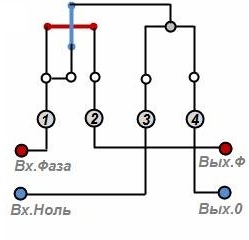
- If there is not a single three-phase consumer in the house and the centralized power supply is connected in one line, the conclusion is unequivocal: it is necessary single phase generator.
- A single-phase unit is also needed when three lines are connected, but only one is required to be backed up (if, for example, the heating system, refrigerator, pumping station, etc., is connected to it).
- If there are single- and three-phase consumers, you can go in two ways: buy two power plants of different designs or still one three-phase, but you must make sure that the loads between the lines are evenly distributed.
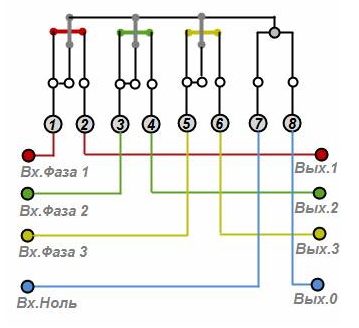
If the house is let down 3 phasesThere are also two options:
- Buy a 3-phase power station and a 3-phase automatic AVR (automatic reserve transfer, which will automatically turn on the generator when the power supply in the centralized network disappears). In this case, it is necessary to lay separate lines in which uniform distribution of loads between them would be provided, and their sum would not be more than a third of the total capacity of the unit (if the generator is designed for 15 kW, no one can be connected to each of the phases more than 5 kW).
- 1-phase generator and 3-phase AVR in the absence of three-phase consumers. In this case, if necessary, the automation will connect all the phases of the network with the generator, and the unit will power each of them simultaneously. At the same time, it is no longer necessary to take care that the loads are evenly distributed.
It is important to take into account when connecting to a three-phase unit network that the maximum permissible phase imbalance is 25% of power.At non-observance of this rule, the generator will simply fail.
Device control options
- Manual start. This type of start is most often used in low power generators. In order to start the unit you will need to strongly pull the cord / twist the handle / press the starter pedal. It must be admitted that this is rather inconvenient and will require considerable physical effort.
- Electrostart. With this design to start it will be enough just to press the button on the panel.
- Autostart In this case, when the mains voltage disappears, the generator will start automatically without operator intervention, and then turn off when power is restored with a set time delay. The only thing that needs to be taken into account for this version of the version is that the automatics will not work if the temperature is less than +5 ˚С, therefore it is required to either install the equipment in a heated container or in a heated room.
Generator fuel consumption
Regardless of the type of equipment, fuel consumption directly depends on:
- from the load connected to the unit,
- efficiency of a particular model
- fuel quality
- contamination of oil and fuel filters.
On average, a gasoline unit can consume 0.3 ÷ 0.45 kg / kWh, and a diesel one, 0.184 ÷ 0.220 kg / kWh.
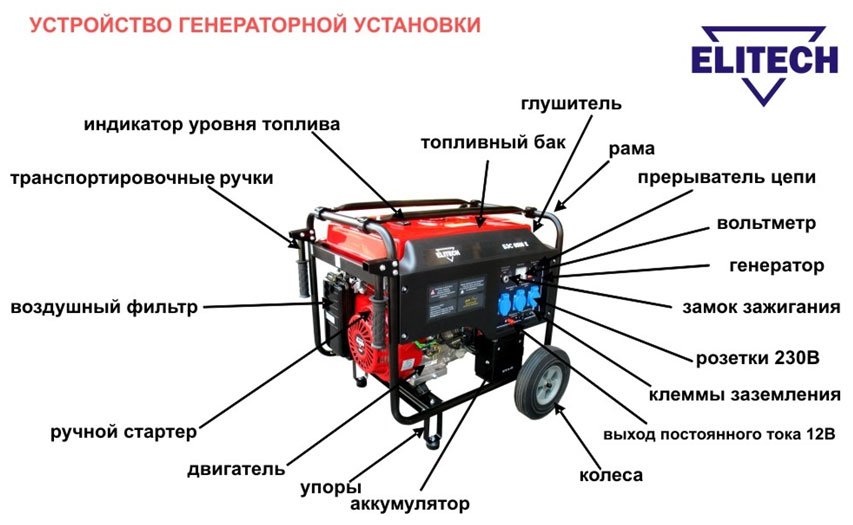
Photo: www.elitech-tools.ru
Electric generator maintenance
In order for the generator to work reliably and efficiently for a long time, maintenance is necessary. All activities that are required to conduct, as well as their frequency, are always prescribed in the manufacturer’s operating instructions. The scope of such work depends largely on the type of equipment, its features, its component parts and their quality.
On average, the frequency of maintenance is 250-300 hours. It is important to periodically check the condition of the oil, air and fuel filters, oil, ventilation system, the degree of belt tension, etc. If necessary, cleaning or replacement of elements.
Popular manufacturers
Choosing a brand of equipment is one of the most important tasks. Among the most popular stand out
- Honda, which is characterized by high and stable quality of production, as well as the possibility of choosing equipment for difficult working conditions, low noise, light start-up, good traction and power indicators.
- Kipor - one of the Chinese brands of high reliability with a large model range of gasoline and diesel units, which is in demand due to the relatively low cost and is perfect for use at home or in the country.
- Huter - the brand, which appeared on the Russian market relatively recently, is notable for low cost, reliability and stability of work, a wide model range, including gas units.
- Bison - Belarusian brand, which is on the same level with leading global brands at an optimal price level.
It is worth noting also widely represented in the market. Hyundai, Sdmo, Wilson, DDE and Fubag.
It is also worth paying attention when choosing a specific model and manufacturer for the presence of a developed network of maintenance centers for this equipment, in order to protect themselves from the long search for the right specialists and spare parts.
